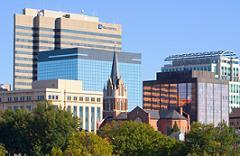The Voice of the City
The Columbia Council of Neighborhoods Celebrates 30 Years of Service
The squeaky wheel might get the grease but only when it's attached to the wagon does it get the full 100-point inspection. That is the philosophy behind the Columbia Council of Neighborhoods (CCN), an organization representing the more than 90 neighborhoods that make up South Carolina 's capital city. The CCN was formed in 1978, when like minds from a handful of Columbia neighborhood associations teamed up. “These individual groups found that they weren't having much success getting initiatives passed through the city government on their own,” explained Tige Watts, current council president. “They decided to use the ‘power in numbers' theory and join forces.” Today, the council boasts nearly 100 percent membership among the city's neighborhood associations, and participation is steadily rising. More than just a bridge between neighborhoods and lawmakers, the CCN has evolved into a vital resource for information, education, and training. Key to the CCN's success has been its ongoing effort to promote open dialogue through forums in which residents, neighborhood leaders, and city officials can freely express ideas and opinions.
Structure of the CCN: The Nuts and Bolts
Before the CCN was established, Columbia 's neighborhood associations functioned largely in isolation, unaware that adjacent communities were simultaneously dealing with similar or like issues. Miscommunications and duplication of effort slowed—and sometimes even halted—progress when petitioning for legislation and funding. The neighborhoods competed unequally for available resources and often experienced difficulty generating a response from city government. Instead, local officials unilaterally decided spending priorities without the input of those impacted by their decisions, which led to disproportionate allocation of funds.
Today, each neighborhood, large or small, that belongs to the CCN has one vote of equal weight to ensure equitable representation. The CCN is governed by a five-person board whose members serve staggered one-year terms (with the exception of the president, who serves for two years). Council participation is voluntary, and neighborhood organizations (rather than the council) are responsible for drafting their own bylaws and defining their community size and geographic boundaries. As a result, member communities that span several miles stand on equal footing with those that encompass only a few blocks. According to Watts , this unique dynamic “creates a real sense of ownership and empowerment,” allowing leaders from diverse communities to collaborate as equal partners for the betterment of their individual neighborhoods and their city.
A Common Thread

Spanning only 134 square miles, Columbia is rather diminutive in size, yet it is an economically and culturally diverse community that is home to an award-winning university, the U.S. Army's largest training base, thriving industry, and a revitalized downtown. Distinct neighborhoods add to the local flavor—from the dogwood-lined streets of Elmwood Park to the stately oaks of Historic Heathwood—making Columbia a desirable place to call home. Despite America 's sagging economy, the city has experienced steady growth in recent years that has not gone unnoticed. Columbia has earned top marks from diverse publications, including Places Rated Almanac , Ladies Home Journal , and Forbes , which has ranked the city as one of the nation's “Best Places for Business and Careers.”
In its 30 years of service, the CCN has stayed true to its mission—“to improve communication between diverse neighborhood groups, recognize common problems, and share solutions”—by striking a delicate balance, helping its members retain their uniqueness while working together to identify and solve mutual problems. According to Watts , “There are some primary quality-of-life concerns that are common to all neighborhoods. At my first meeting as president, I asked each attendee to introduce him- or herself and say in four words or less what their biggest neighborhood issue was. I found that problems were quite similar; they just differed in intensity.” For example, historic Elmwood Park , a residential enclave located near both the university and city center, has experienced an increase in the number of speed violators who cut through its quiet streets and threaten public safety. Leroy Wilson, president of the Elmwood Park Neighborhood Association has plans to share his concerns at an upcoming council meeting and to ask for suggestions from fellow council members on how best to bring the problem to the attention of the city manager. “We like council meetings because other members fall in and try to help us out,” said Wilson . “At our meetings, we try to connect and make sure we look out for one another.”
Willingness to pitch in and help is a trait that defines CCN members, even when the problem at hand is in someone else's back yard. “Lately, as the economy has declined, we've begun to see a spike in crime here in Columbia ,” explained Watts . “Although crime tends to be centered in certain sections of the city, all our neighborhood members are concerned.” The council is working proactively to address worries such as drug trafficking, youth violence, and gang-related crimes before they can escalate into city-wide problems.
In every society, conflicts of interest are inevitable. The CCN has been very successful at working with its members, the city, and private entities to find win-win solutions when occasional impasses have occurred. One ongoing controversy involves the construction of new housing projects in Columbia . Some neighborhoods support the building of large residential properties, commonly called “McMansions,” contending that development helps the economy, whereas others groups decry the loss of green space and traditional neighborhood character. Historic preservationists joined the debate in 2007 after a historic 87-year-old farmhouse was razed in the Heathwood to make room for a new subdivided housing project. The CCN's first step toward mediating this contentious issue involved good, old-fashioned reconnaissance. “I phoned all of our council members to find out their opinions about development. It made for some interesting conversations,” Watts said. Further meetings with private developer yielded other surprises. “In the end, we found that all parties involved—residents, builders, and city officials—had similar hopes and concerns. We became a bridge between developers and neighborhoods and, as such, were able to work out a compromise.” Neighborhood representatives were successful in convincing the city council to set up a two-year interim “opt in” plan, which allows neighborhoods to apply for temporary protection against demolitions, subdivisions, and structural removals while the development issue is under review. The plan also addresses the size of new construction in relation to existing homes.
Getting to Know You
Opportunities for one-on-one interaction with local leaders are a major perk of CCN membership according to Mary Baskin-Waters, co-president of the Historic Heathwood Neighborhood Association and former CCN secretary: “What I like most about the CCN is meeting people I ordinarily wouldn't have a chance to meet. I enjoy being able to speak with the mayor, the city manager, as well as other neighborhood association presidents at monthly meetings.” Nonpartisan by charter, the CCN works to promote ongoing dialogue between neighborhood leaders, political hopefuls, and elected city officials. “We feel the people need to be educated,” said Watts . “The council has organized a number of meet-and-greets, evenings with the mayor, and other events that bring community members together.” This past march, the CCN hosted a debate between city council candidates. Last year, when the city of Columbia began a search for a new chief of police, the CCN met with the selection committee to ensure that neighborhood concerns were addressed. “Previously, the community policing program wasn't very active in Columbia . We stressed that the new chief needed to make community policing a priority.” The council also monitored the committee's progress and made sure that it scheduled ample time for the candidates to respond to neighborhood questions.

Networking is more than just clocking hours in the boardroom. It's also getting outdoors, shaking hands, volunteering, and, hopefully, sharing a few laughs with one's fellow community members. The CCN kicked off its 30-year anniversary celebration by partnering with local hospital network Palmetto Health to offer free health screenings in conjunction with the Martin Luther King Day rally this past January. In March, the CCN joined with Keep the Midlands Beautiful ( Columbia 's Keep America Beautiful affiliate) to sponsor the Midlands Makeover Challenge, a two-month-long series of events designed to promote neighborhood beautification and recycling. The council plans to award $500 in prize money to winning neighborhood participants.
The CCN also has established a program to recognize deserving individuals and organizations. At its annual banquet, the council presents three awards: Neighborhood Volunteer of the Year (an individual who has made his or her neighborhood a better place to live), CCN Friend of the Year (an individual who has helped the council achieve its objectives) and the CCN Special Recognition Award (an individual or institution that has had a far-reaching impact within the city of Columbia). The May 2008 banquet will include a new feature: the induction of the first CCN class into the Columbia Neighborhood Hall of Fame.
Lending a Helping Hand
Over its 30-year history, the CCN has evolved into both a support mechanism and an information clearinghouse for neighborhood association representatives. “When new neighborhood associations form, they usually are sent to us right away. We can provide assistance in a number of ways—helping them set up automated call programs, looking up old laws, and researching zoning issues, for example,” said Watts . The council continues to branch out in order to meet changing member needs, most recently by expanding its educational opportunities through development of training workshops, open-house forums, and debates.
The CCN also provides financial assistance to deserving communities. In 2007, the council contributed $100 each to some 87 neighborhoods to help fund local National Night Out activities. The council also has been instrumental in securing money for the Can Do program, which provides grant money to neighborhoods for beautification, construction, educational, and other improvement projects. Elmwood Park spent its Can Do grant monies to install lighting outside some of its historic properties, and the Brandon Acres/Cedar Terrace Neighborhood Association used its funds to improve street signage.
The reward for the Columbia Council of Neighborhood's dedication to service is a growing interest council participation from nonmembers and unparalleled esprit de corps within the current membership. “Not only are we getting more attendees at meetings, but the quality of participation has improved, too,” Watts said. “I'm seeing a lot more energetic people getting involved in their neighborhoods.”
Links
- http://www.columbiasc.net/ (City of Columbia homepage. Includes links to Columbia neighborhoods, city council, and city government.)
- http://www.thestate.com (State of South Carolina homepage)
- www.Thecolumbiastar.net (weekly newspaper from the city of Columbia . Includes archived city council minutes.)
- http://www.columbiachamber.com/ (Columbia Chamber of Commerce)



